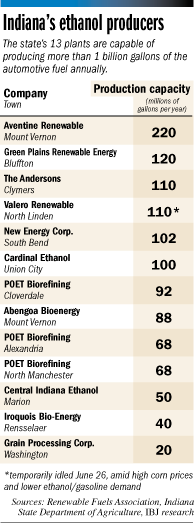Subscriber Benefit
As a subscriber you can listen to articles at work, in the car, or while you work out. Subscribe NowIndiana’s 13 plants distilling the automotive fuel ethanol could soon be sputtering as drought dries up the supply and boosts the price of corn, their main ingredient.
Strain in the nation’s fourth-largest ethanol-producing state became apparent June 26, when Valero Energy temporarily idled its 110-million-gallon plant in Linden.
San Antonio-based Valero cited challenging margins caused by higher corn prices.
Over one period last month, the future price of a bushel of corn jumped from around $5 to $6.33.
“I’m not a weather forecaster,” said Purdue agricultural economist Wally Tyner, but “if drought continues through summer … that’s bad news for ethanol producers.”
At stake are about 600 jobs at the state’s ethanol plants, along with the livelihoods of Indiana farmers who supply 431 million bushels of corn each year to make more than 1 billion gallons of alcohol fuel.
June was the driest month on record for Indianapolis and Evansville, according to the National Weather Service. Indianapolis received just 0.09 of an inch of rain.
Last month, the U.S. Department of Agriculture issued a forecast that August corn stockpiles would fall to a 16-year low, due to drought in the corn belt.
“Certainly, right now, margins are quite slim with a lot of plants,” said Matt Hartwig, spokesman for the Renewable Fuels Association.
Hartwig, however, called it a “case by case” situation. “A lot will depend on the economics and the efficiencies of the [particular] plant.”
The largest ethanol maker in Indiana, POET Biofuels, declined to say whether it had plans to slow or suspend production at its plants in Alexandria, Cloverdale and North Manchester.
South Dakota-based POET has dealt with varying market conditions over the last 25 years.
“Managing the ups and downs of the commodities market is part of the business,” said spokesman Matt Merritt. “Risk management and optimizing plant performance is an important part of what we do.”
Some ethanol producers will ratchet down production a bit. Others will perform extended maintenance while still others will add capacity to produce byproducts.
While most ethanol plants also make distiller’s grains, which are sold as cattle feed, about 60 percent of the industry has added equipment to extract corn oil for sale.
At plants such as Cardinal Ethanol, in Union City, corn-oil sales generated $1.8 million of its $77.7 million in sales during the first quarter.
It’s a small but rising percentage of the company’s sales: rising to 2.3 percent from less than 1 percent during the same quarter in 2011, according to filings with the Securities and Exchange Commission.
 “High corn prices will have a negative effect on our operating margins unless the price of ethanol and distiller’s grains outpaces rising corn prices,” the company said.
“High corn prices will have a negative effect on our operating margins unless the price of ethanol and distiller’s grains outpaces rising corn prices,” the company said.
The industry also is trying to develop additional byproducts for industrial purposes, such as a building block for plastics and polymers.
But ethanol is still the cash cow for these plants, generating 79 percent of the revenue at Cardinal, for example.
The ethanol industry has been trying to find additional demand for the fuel, including a boost in how much is typically mixed with ordinary gasoline to make it burn more completely.
Currently, most gas sold by retailers contains about 10 percent ethanol.
The Environmental Protection Agency last month gave final approval for the sale of gasoline containing a 15-percent mix of ethanol, for vehicles built after 2001.
The Renewable Fuels Association said it will be a while, however, before that translates to meaningful sales increases. One hurdle is that some gas stations have to upgrade their pumps to handle the more corrosive blend of fuel.
There also have been lawsuits filed that challenge the safety of the fuel in non- “flex fuel” vehicles. Flex-fuel vehicles can burn a gasoline mix that contains up to 85 percent ethanol because their fuel systems are made from materials more alcohol-tolerant.
Flex-fuel vehicles haven’t been as popular as once hoped because fuel economy is effectively lower with E85. It must sell at a relative discount to ordinary gasoline to be as cost-effective.
Another problem is that the market is currently flooded with ethanol, with 140 companies now operating 200 plants in the United States.
That may portend additional shakeouts of marginal ethanol makers.
Valero said workers at its idled plant in Linden will continue to be employed full time, but will perform maintenance and other tasks for the time being.•
Please enable JavaScript to view this content.
